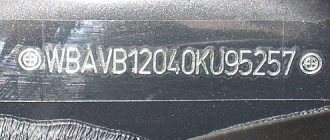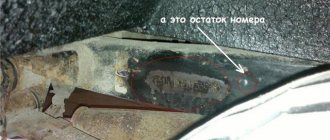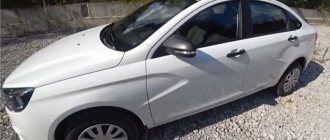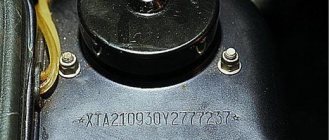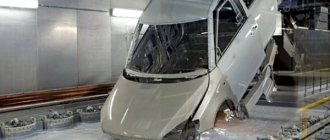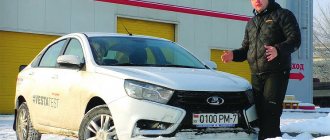By law, each vehicle has an identification number (VIN code). This number is recorded in the vehicle passport (PTS). The identification number and other passport data are indicated on the summary plate, and the VIN code is also stamped on the body. Do you know where the VIN code and engine number are located on Vesta?
Location of the VIN number on the body of the Lada Vesta SV Cross
As on most modern cars, the VIN number of the Lada Vesta SV Cross is printed on two of its parts. This is the right center pillar and the side wall of the engine compartment. In addition to the main places for applying this code, there is an additional plate, which is also located on the central pillar. Japanese manufacturers use a similar arrangement of VIN numbers. There is no VIN number on the SV Cross either under the seat or under the windshield. This is confirmed in the operating manual for this vehicle.
A typical sign with a VIN number on the right center pillar looks like this:
An additional plate with a printed code looks like this:
And this is the VIN number located on the wall in the engine compartment:
WMI
WMI – International Manufacturer Identification Code. Consists of three characters (letters or numbers).
The first symbol indicates a geographic area, the second indicates a country within that area, and the third indicates a specific manufacturer (sometimes a vehicle type).
If the manufacturer produces less than 500 DTS per year, then the third character of the code is the number 9.
Several WMIs may be assigned to a manufacturer, but the same number may not be assigned to another vehicle manufacturer for at least 30 years from the moment it was first used by the previous (first) manufacturer.
So, the first character of WMI is a letter or number indicating the geographic area code. Each zone is assigned several symbols:
- from A to H – Africa;
- from J to R – Asia;
- from S to Z – Europe;
- from 1 to 5 – North America;
- from 6 to 7 – Oceania;
- from 8 to 9 – South America;
The second character (country code) is a letter or number that represents the country. To ensure flexibility and unambiguity in identification, a specific country is determined by a combination of the first and second digits of the code:
Despite the parameters clearly stated in the standard, the designation assigned to the country of origin is not always used. For example, cars of the European branch of General Motors, whose head office is in Germany, are labeled as W0, regardless of the country of origin (be it Germany, Spain, Great Britain, Belgium or Poland).
The third character is a letter or number that is assigned to the manufacturer by the national organization. Can also mean vehicle type or production department.
Decoding the characters contained in the duplicate table
- Manufacturing company;
- Vehicle type number;
- Identification number (VIN);
- Maximum permissible vehicle weight;
- Maximum permissible weight of a car with a trailer;
- Maximum load on the front axle;
- Rear axle load limit;
- Code for spare parts;
- Engine modification;
- Vehicle equipment.
Unlike many foreign cars, the plate on the Vesta SV Cross does not contain information about the car’s color number.
Why is this information useful?
- When registering a car (the traffic cop will inspect and check the identity of the numbers on the body and in the title)
- To decipher the package (see below).
Decoding the sign
1 - vehicle manufacturer; 2 — vehicle approval number; 3 VIN code; 4 — permissible maximum weight; 5 - maximum permitted weight with trailer; 6 — permissible load on the front axle; 7 — permissible load on the rear axle; 8 - code for spare parts; 9 — engine model; 10 - modification of the car.
Decoding the VIN number of Lada Vesta
Now, let's talk about the symbols in the vehicle identification number. Each symbol carries information of a different nature: from manufacturer to body type, etc. For example, let's take the available VIN number of the Lada Vesta: XTAGFK330JY144213.
- The first three characters contain information about the manufacturer. In our case, this is XTA - AvtoVAZ.
- Characters 4 and 5 are the model code: GF - Vesta (GA - XRay).
- The symbol following them indicates the body type: K - station wagon, also B - hatchback, L - sedan).
- Character 7 is the engine code. In this case, 3 is 21179 (in addition to it there is 1 - 21129, 2 - 11189, 4 - H4M).
- Character 8 - gearbox type. 3 — Renault manual transmission. There may also be 1 - manual transmission VAZ and 2 - AMT.
- The 9th character is always 0.
- The tenth character indicates the model year. J - 2022 The marking of Lada Vesta begins in 2015, which corresponds to the Latin letter F. Next, respectively, are G, H, J, K, L, M and N (until 2022).
- The 11th character following it is the plant code. In our case, this is Y - Izhevsk. May stand O - Tolyatti.
- Characters 12 to 17 are the serial number of the specific vehicle.
You may also be interested in: Best new car under 500 thousand rubles: rating
Below is a video that clearly shows where the VIN number is located in the Lada Vesta:
LADA LARGUS CLUB
Official Lada Largus Club
presents a short photo report from the engine assembly shop licensed by the Renault-Nissan
. AVTOVAZ launched new production in November 2013. The assembly of 16-valve engines of the K family (1.6 liters, 105 hp) and gearboxes of the J family of various modifications has already been mastered here. Power units are designed for the production of Lada Largus
.
They are also planned to be installed on other car models produced at Alliance factories as part of the partnership between Renault-Nissan
and
AVTOVAZ
.
Photo report:
1. Upon entering the line, the cylinder block is assessed for the dimensions of these same cylinders. A special scanner reads the code and enters the information into a memory unit on a pallet (a stand on which the motor runs along the entire line).
2. The circles on the left are the block size code. The numbers 957 indicate the serial number of the motor. Commercial production began with number 414. 413 motors were assembled during the line setup period, and more than half were assembled in Italy, at (line supplier).
3. The crankshaft also has several size classes - according to them, the computer selects connecting rod and main bearings. Before installation, the crankshaft is also scanned, reading its size using the code.
4. Sub-assembly of the connecting rod and piston group. The photo shows the installation of piston rings using a special mandrel.
5. Installation of pistons. They are selected according to the cylinder class. The computer allows the assembler to take only the required size pistons from the stand.
6. After installation, the camera photographs the pistons so that the information system makes sure that they correspond to the block.
7. The scan results are displayed on the screen.
8. Each assembly operation is displayed on a monitor or a special information stand. The images of bolts and nuts change color after tightening. The intelligent impact wrench evaluates the tightening sequence - if it is broken, the impact wrench will not turn on.
9. After installing the crankshaft and piston group, the engine is cranked on an automatic stand, where the ease of rotation is assessed. If rotation is difficult, then an error has been made. The engine lubrication system is also tested here: the oil channels are purged.
10. Before installing the cylinder head gasket, the assembler must take it and insert it into the special groove. This protects against the use of 2 gaskets at once (they will not fit into the groove) and against the fact that a person simply forgets to install the gasket.
11. Tightening procedure using a pneumatic wrench.
12. Installation of valves.
13. Camshaft and valve lifters.
15. The trolley, with the help of which assembly kits for the next batch of engines are delivered to the line, drives itself along a route marked with a black stripe. This allows you to synchronize the process and avoid delays and errors in delivery.
16. After assembly, all engines are sent to a test bench, where coolant and gasoline are connected, and the engine operates in all modes - idling, under load.
Location of Lada Vesta engine number
Seeing the number on a Lada Vesta engine is not an easy task. The number itself is located at the end of the cylinder block, near the gearbox. However, knowing the location isn't everything. If you need to get a good look at the number, you will have to resort to using a cane mirror and a flashlight. Also, this element of the engine design bears the designation of the engine model.
What to do if you lose your VIN plate due to various circumstances
As numerous crash tests of the Lada Vesta have shown, in the event of a side impact, the central pillar (where the plate with the VIN number is located) moves into the car interior. As a rule, in the event of such an accident there is no choice but to replace the central pillar. Well, if you are unlucky and have lost your identification plate as a result of an accident or other body repair, the fate of your car is then at the mercy of the law.
The fact is that traffic police officers must check the VIN number with the number located under the hood of the car. If the reconciliation is successful and without problems, the car will be registered. If traffic police officers have any suspicions, the car will be sent for examination. And after the examination, if everything goes smoothly, you can go to register the vehicle.
Below is a video about the VIN number in the Lada Vesta SV Cross car:
Registration without VIN code
It happens that the middle pillar with VIN on the Lada Vesta is damaged and requires replacement. Such troubles can be the result of an accident, unsuccessful repairs, or an example of the “work” of rust. It is difficult to check and update information about a car: AvtoVAZ does not provide for the restoration of identification data. Therefore, information about further operation should be obtained from the traffic police.
When checking, it may turn out that the Lada Vesta’s VIN number is difficult to distinguish or is missing. Further, in order to avoid cases of fraud, certain seals are installed on the car and stamps are placed. Photos of the damaged area are entered into the unified traffic police database. The documents are sent to the police department. All this time, the car will be on a special site, where it will be examined by forensic experts. If everything is fine with the history, the owner will be allowed to reapply the identifier to the body. Labeling work is carried out by a certified laboratory or manufacturer.
Source
